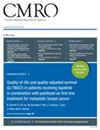Arnaud Bourdin, Ioanna Vlachaki, Alessandra Madoni, Simon Donhauser, Marielle van der Deijl, Mithun Chakrawarthy Manne, Bala Ganesh Geddamuri, Nicola A Hanania
求助PDF
{"title":"对严重/难治性哮喘的人文、经济、社会人口和环境负担的系统回顾。","authors":"Arnaud Bourdin, Ioanna Vlachaki, Alessandra Madoni, Simon Donhauser, Marielle van der Deijl, Mithun Chakrawarthy Manne, Bala Ganesh Geddamuri, Nicola A Hanania","doi":"10.1080/03007995.2025.2513963","DOIUrl":null,"url":null,"abstract":"<p><strong>Objective: </strong>We examined gaps in our understanding of the health-related, humanistic, socioeconomic, and environmental burden of patients with difficult-to-treat/severe asthma.</p><p><strong>Methods: </strong>A systematic literature review was performed using Embase and MEDLINE. The searchs were performed separately for studies investigating humanistic and economic burden and those investigating environmental and sociodemographic impact, using a predefined search strategy. Study selection was based on the population, interventions, comparisons, outcomes, and study design framework. Data extraction from full-text publications was conducted using a standardized Microsoft Excel© template.</p><p><strong>Results: </strong>Fifty-two studies reporting the humanistic and economic burden and 11 studies reporting the environmental and sociodemographic impact were identified. Patients with severe vs non-severe asthma had lower quality of life (QoL). As expected, the impact of asthma on healthcare resource utilization and costs increased with disease severity. More frequent hospitalizations, emergency department visits, longer hospital length of stay, and higher frequency of exacerbations were seen in severe vs non-severe asthma. Eleven studies reported on factors such as air pollution and their association with increased risk of asthma severity, and there is a lack of evidence specifically addressing its impact on severe asthma.</p><p><strong>Conclusion: </strong>Severe asthma imposes significant economic and humanistic burdens on patients and healthcare systems. Both environmental and sociodemographic factors exacerbate asthma severity and should be further investigated to ensure optimal asthma management. Gaps remain in our knowledge of the impact of climate change on the most vulnerable patients with severe disease and our review highlights aspects of this burden that are still to be fully understood.</p>","PeriodicalId":10814,"journal":{"name":"Current Medical Research and Opinion","volume":" ","pages":"1075-1095"},"PeriodicalIF":2.2000,"publicationDate":"2025-06-01","publicationTypes":"Journal Article","fieldsOfStudy":null,"isOpenAccess":false,"openAccessPdf":"","citationCount":"0","resultStr":"{\"title\":\"A systematic review of the humanistic, economic, sociodemographic, and environmental burden of severe/difficult-to-treat asthma.\",\"authors\":\"Arnaud Bourdin, Ioanna Vlachaki, Alessandra Madoni, Simon Donhauser, Marielle van der Deijl, Mithun Chakrawarthy Manne, Bala Ganesh Geddamuri, Nicola A Hanania\",\"doi\":\"10.1080/03007995.2025.2513963\",\"DOIUrl\":null,\"url\":null,\"abstract\":\"<p><strong>Objective: </strong>We examined gaps in our understanding of the health-related, humanistic, socioeconomic, and environmental burden of patients with difficult-to-treat/severe asthma.</p><p><strong>Methods: </strong>A systematic literature review was performed using Embase and MEDLINE. The searchs were performed separately for studies investigating humanistic and economic burden and those investigating environmental and sociodemographic impact, using a predefined search strategy. Study selection was based on the population, interventions, comparisons, outcomes, and study design framework. Data extraction from full-text publications was conducted using a standardized Microsoft Excel© template.</p><p><strong>Results: </strong>Fifty-two studies reporting the humanistic and economic burden and 11 studies reporting the environmental and sociodemographic impact were identified. Patients with severe vs non-severe asthma had lower quality of life (QoL). As expected, the impact of asthma on healthcare resource utilization and costs increased with disease severity. More frequent hospitalizations, emergency department visits, longer hospital length of stay, and higher frequency of exacerbations were seen in severe vs non-severe asthma. Eleven studies reported on factors such as air pollution and their association with increased risk of asthma severity, and there is a lack of evidence specifically addressing its impact on severe asthma.</p><p><strong>Conclusion: </strong>Severe asthma imposes significant economic and humanistic burdens on patients and healthcare systems. Both environmental and sociodemographic factors exacerbate asthma severity and should be further investigated to ensure optimal asthma management. Gaps remain in our knowledge of the impact of climate change on the most vulnerable patients with severe disease and our review highlights aspects of this burden that are still to be fully understood.</p>\",\"PeriodicalId\":10814,\"journal\":{\"name\":\"Current Medical Research and Opinion\",\"volume\":\" \",\"pages\":\"1075-1095\"},\"PeriodicalIF\":2.2000,\"publicationDate\":\"2025-06-01\",\"publicationTypes\":\"Journal Article\",\"fieldsOfStudy\":null,\"isOpenAccess\":false,\"openAccessPdf\":\"\",\"citationCount\":\"0\",\"resultStr\":null,\"platform\":\"Semanticscholar\",\"paperid\":null,\"PeriodicalName\":\"Current Medical Research and Opinion\",\"FirstCategoryId\":\"3\",\"ListUrlMain\":\"https://doi.org/10.1080/03007995.2025.2513963\",\"RegionNum\":4,\"RegionCategory\":\"医学\",\"ArticlePicture\":[],\"TitleCN\":null,\"AbstractTextCN\":null,\"PMCID\":null,\"EPubDate\":\"2025/6/18 0:00:00\",\"PubModel\":\"Epub\",\"JCR\":\"Q1\",\"JCRName\":\"MEDICINE, GENERAL & INTERNAL\",\"Score\":null,\"Total\":0}","platform":"Semanticscholar","paperid":null,"PeriodicalName":"Current Medical Research and Opinion","FirstCategoryId":"3","ListUrlMain":"https://doi.org/10.1080/03007995.2025.2513963","RegionNum":4,"RegionCategory":"医学","ArticlePicture":[],"TitleCN":null,"AbstractTextCN":null,"PMCID":null,"EPubDate":"2025/6/18 0:00:00","PubModel":"Epub","JCR":"Q1","JCRName":"MEDICINE, GENERAL & INTERNAL","Score":null,"Total":0}
引用次数: 0
引用
批量引用
A systematic review of the humanistic, economic, sociodemographic, and environmental burden of severe/difficult-to-treat asthma.
Objective: We examined gaps in our understanding of the health-related, humanistic, socioeconomic, and environmental burden of patients with difficult-to-treat/severe asthma.
Methods: A systematic literature review was performed using Embase and MEDLINE. The searchs were performed separately for studies investigating humanistic and economic burden and those investigating environmental and sociodemographic impact, using a predefined search strategy. Study selection was based on the population, interventions, comparisons, outcomes, and study design framework. Data extraction from full-text publications was conducted using a standardized Microsoft Excel© template.
Results: Fifty-two studies reporting the humanistic and economic burden and 11 studies reporting the environmental and sociodemographic impact were identified. Patients with severe vs non-severe asthma had lower quality of life (QoL). As expected, the impact of asthma on healthcare resource utilization and costs increased with disease severity. More frequent hospitalizations, emergency department visits, longer hospital length of stay, and higher frequency of exacerbations were seen in severe vs non-severe asthma. Eleven studies reported on factors such as air pollution and their association with increased risk of asthma severity, and there is a lack of evidence specifically addressing its impact on severe asthma.
Conclusion: Severe asthma imposes significant economic and humanistic burdens on patients and healthcare systems. Both environmental and sociodemographic factors exacerbate asthma severity and should be further investigated to ensure optimal asthma management. Gaps remain in our knowledge of the impact of climate change on the most vulnerable patients with severe disease and our review highlights aspects of this burden that are still to be fully understood.

 求助内容:
求助内容: 应助结果提醒方式:
应助结果提醒方式:


